Swing music is the heartbeat of jazz, famous for its infectious rhythms and captivating grooves that people love.
It is a style that emerged during the swing era and continues to influence modern music, from jazz to pop and beyond.
As an artist or producer, knowing all about swing music can seriously elevate your musicality and production skills.
Plus, it adds a timeless quality to your tracks that resonates with listeners, which is why we’re breaking down everything you need to know, like:
- What is swing in music ✓
- Elements of swing music ✓
- Swing rhythms and timing ✓
- Swing feel and groove ✓
- Key instruments in swing music ✓
- Triplet feel vs. straight eighths ✓
- Syncopation and accents ✓
- Role of the rhythm section ✓
- Swing era history & music theory ✓
- How musicians play swing/how you could learn swing ✓
- Much more about what is swing in music ✓
After this article, you’ll know everything about swing music so you can incorporate its rhythms and feel into your own tracks.
As well as understand its history and overall appeal to create tracks that groove and swing authentically.
This way, you’ll have some solid knowledge and expert tips for playing and producing swing music like a boss.
You’ll never have to wonder, “what is swing in music” again.
So, let’s dive in…
Table of Contents
What is Swing in Music?

Swing in music is a unique rhythmic feel that gives jazz its signature groove and bounce that gets people up and moving.
Swing music emerged during the swing era in the early 20th century, particularly popping off in Kansas City.
This style became synonymous with big swing bands like those led by Duke Ellington and Benny Goodman, who are real legends if you didn’t know.
Swing rhythm relies heavily on syncopated rhythms and swung eighth notes, creating a distinctive rise and fall that makes you want to dance.
Unlike the evenly spaced eighth notes in classical music, swung eighth notes in swing music have a triplet feel 一 making the first note longer and the second note shorter.
This rhythmic feel can be found in many genres, including jazz, blues, and even some pop music (anything that could be defined as ‘easy listening’ basically).
The swing feel is essential for musicians playing jazz records from the swing era and those who want to incorporate a hybrid edge.
Learning swing rhythms can seriously enhance your versatility as a musician and producer, which is why we’re breaking it all down throughout the article.
The Elements of Swing Music: Breaking it Down
To truly master what is swing in music, you need to understand its core components, of course. So, let’s kick things off by breaking down the elements that make swing music so captivating and enduring.
-
Swing Rhythms and Timing
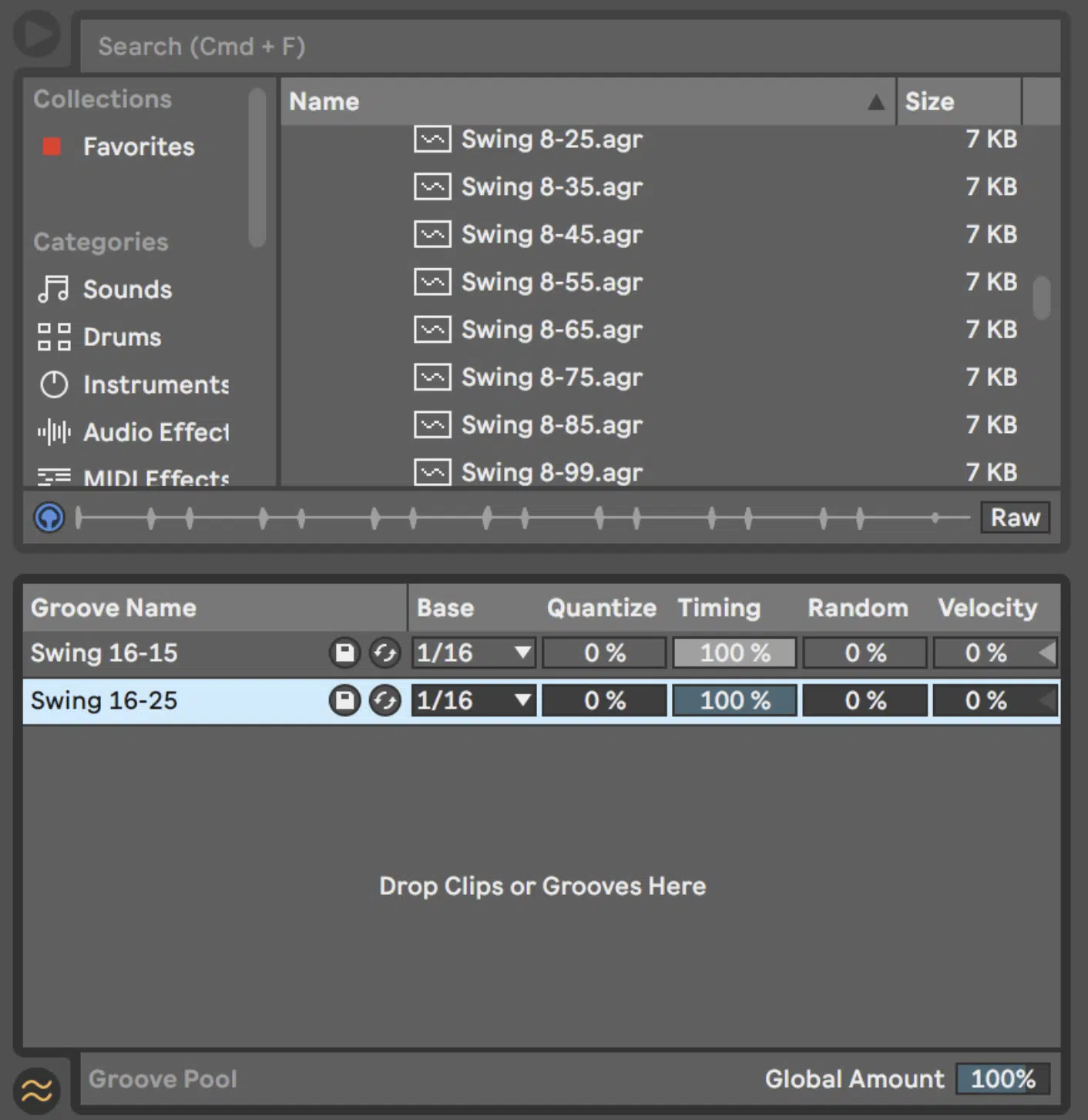
Ableton Live Groove Pool can help you with swing all day.
Swing rhythms are the backbone of swing music, creating the genre’s unmistakable groove, characterized by their syncopated rhythm and more emphasis on the off-beats.
This is what gives swing music its lively, bouncing quality.
The most defining feature of swing rhythms has to be the swung eighth notes.
Unlike a straight eighth note, which divides the beat evenly, swung eighth notes elongate the first note of the pair and shorten the second note.
This creates a rhythmic pattern that feels more relaxed and danceable.
Swing rhythms also frequently use syncopation (where accents fall on the weaker beats), adding to the music’s dynamic and unpredictable feel.
This rhythmic pattern became a hallmark of the swing era and influenced many other genres 一 including rock and blues.
For musicians, mastering swing rhythms involves feeling the beat’s inherent swing and learning to play with a natural, laid-back groove.
NOTE: This can be achieved through practice and listening to any classic example from big swing bands like Royal Crown Revue.
-
Swing Feel and Groove
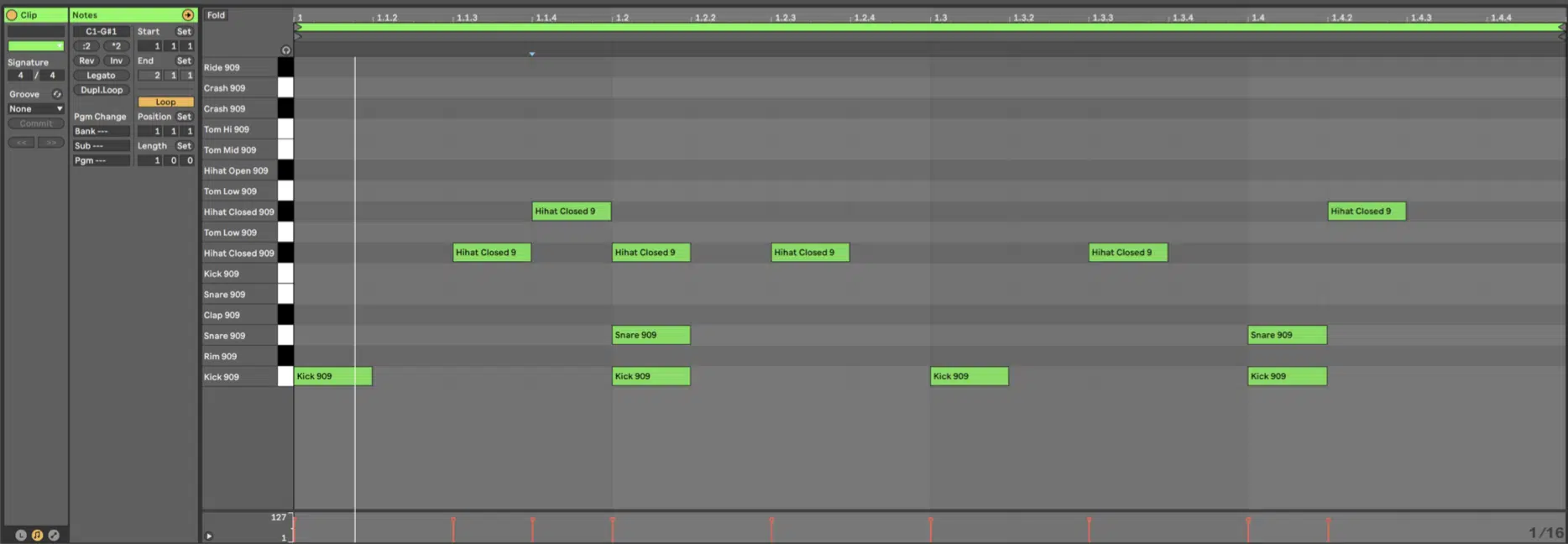
The swing feel is the heart and soul of swing music, giving it that infectious, toe-tapping quality that people get pretty much addicted to.
This feel is achieved through:
- The interplay of swung rhythms
- Syncopation
- The natural groove of the musicians playing together
The swing feel relies heavily on the rhythm section, particularly the bass and drums, to lay down a solid foundation.
The bass often plays a walking line, emphasizing the beat’s pulse, while the drums use a shuffle rhythm on the ride cymbal or hi-hat.
This combination creates a super smooth, rolling groove that propels the music forward and keeps people engaged.
Swing feel also involves a subtle push and pull between the musicians, with slight variations in timing and greater emphasis that add to the music’s dynamic character.
This rhythmic feel is not just about playing the right notes but about capturing the music’s spirit and energy.
For producers and musicians like yourself, understanding and replicating the swing feel is crucial for creating authentic swing music (and it’s all about authenticity).
-
Key Instruments in Swing Music
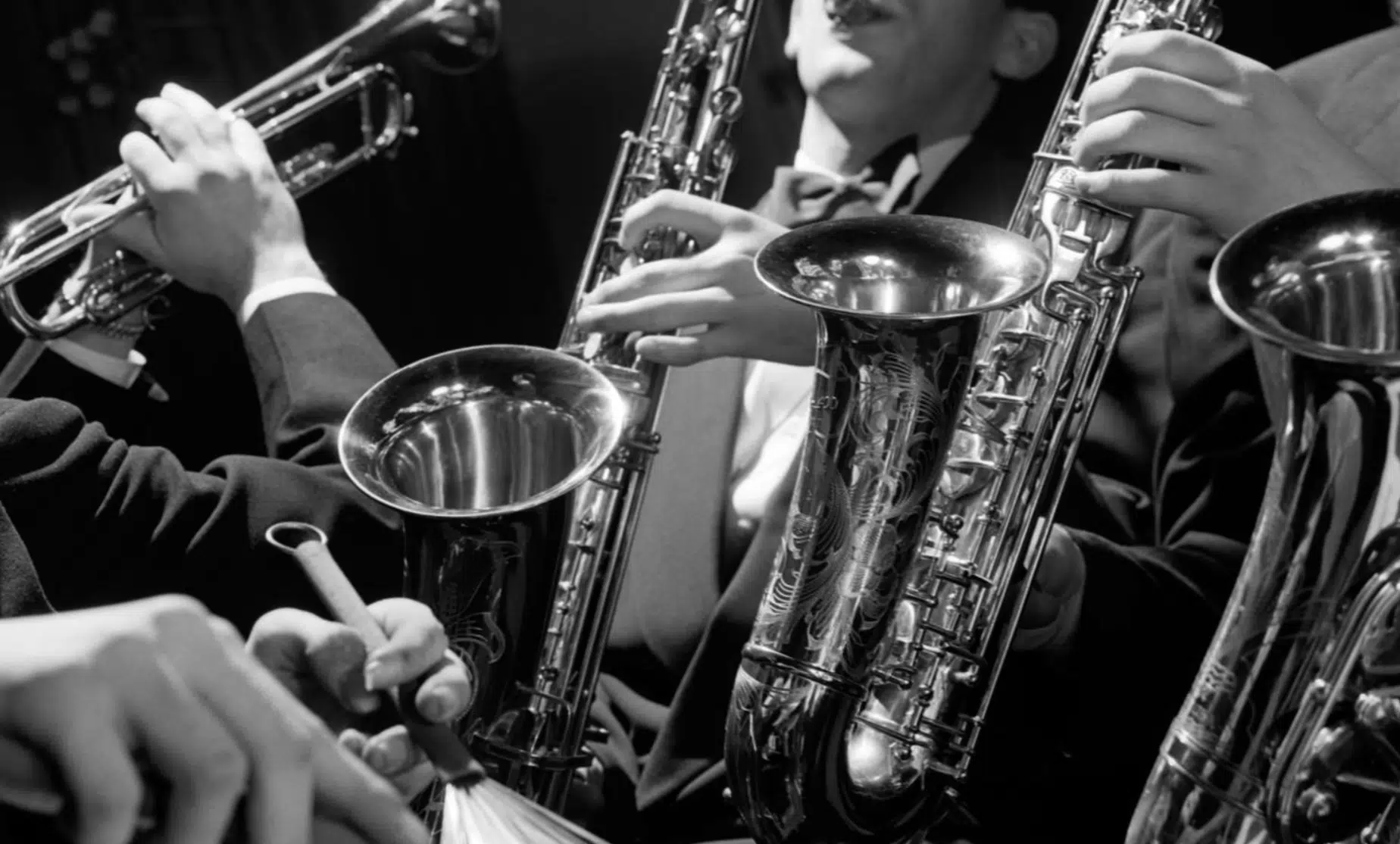
Swing music’s rich and textured sound comes from its unique instrumentation, with key instruments that really give the genre its signature sound.
The rhythm section (the bass, drums, and piano) forms the backbone of swing music.
The bass, often a double bass, plays a walking bassline and provides the harmonic foundation and rhythmic pulse.
Drums, especially the bass drum, ride cymbal, and hi-hat, add to the swing feel with their syncopated rhythms and shuffle patterns.
The swing piano adds harmonic edge and rhythmic complexity, often playing syncopated chords and melodic lines.
Brass and woodwind instruments, in addition to the rhythm section, play a huge role in swing music.
Trumpets, trombones, and saxophones are also staples of big swing bands 一 contributing to the music’s powerful and dynamic sound.
These instruments often play intricate arrangements, with solos all day.
Understanding the role of each instrument in swing music will help you create on point and show-stopping swing songs.
Understanding Swing Rhythms
Now, to dive deeper into what is swing in music, it’s super important to break down the specific rhythmic concepts that basically define this genre. Understanding these rhythms will enhance your ability to play and produce swing music authentically.
-
Triplet Feel vs. Straight Eighths
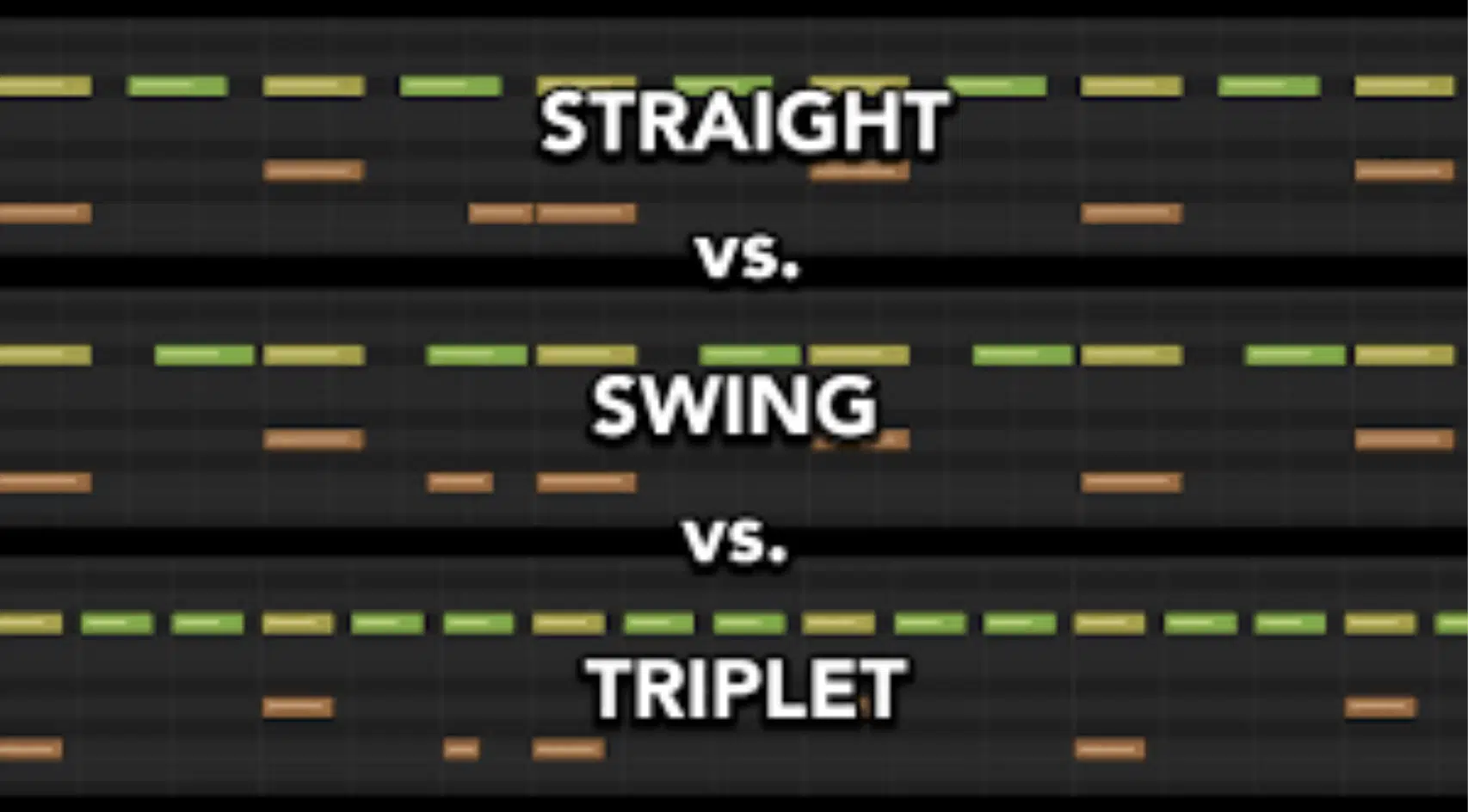
One of the most distinguishing features of swing music is its triplet feel, which contrasts sharply with the straight eighths found in classical and pop music.
In straight eighth notes, each beat is divided into two equal parts, which gives you evenly spaced eighth notes.
In swing music, however, the beat is divided into three parts 一 creating eighth note triplets (which is everything in this genre).
You’ll play only the first and third notes of these triplets, which gives swing its characteristic tension/release and bounce.
NOTE: This triplet feel can be challenging for those accustomed to straight eighths, but it’s key for achieving the authentic swing rhythm.
A good example would be, in a straight rhythm, you might count “1 and 2 and 3 and 4,” while in a swing rhythm, you would feel it as “1-a 2-a 3-a 4-a.”
The difference in timing creates a more relaxed and danceable groove, essential for jazz and dance music.
This rhythmic pattern became a hallmark of the swing era, influencing many other genres, including Kansas City jazz and blues.
To master this, listen to swing songs by any reputable swing band and practice playing with the triplet feel as I mentioned earlier; it’s really the key.
-
Swing Eighth Notes

Swung eighth notes are the cornerstone of swing music if you will, setting it apart from other styles and genres.
I know we covered it a tad already, but you really need to know about them to understand what is swing in music.
Unlike the evenly spaced eighth notes in classical music, swung eighth notes have a long-short pattern that gives swing its distinctive groove.
When playing swung eighth notes:
- The first note in the pair is longer.
- The second note is shorter, creating an uneven feel.
This pattern is often described as having a triplet feel, where the first and third notes of a triplet are played, but the middle note is skipped.
This creates a rhythmic pattern that feels both relaxed and driving, which is essential for mastering the swing feel as a whole.
For example, in a typical swing rhythm, you might play the first note of the triplet longer and the second note shorter 一 resulting in a “long-short” pattern.
Practicing swung eighth notes can be challenging at first, but stick with it, focus on internalizing the swing feel, and experiment with different ways to articulate the swung rhythm.
This particular way of doing things is everything when it comes to playing swing music like a professional, so don’t overlook it.
It is a fundamental skill for any jazz musician or modern producer who wants to add some unique flair to their music.
The Swing Era: Quick History
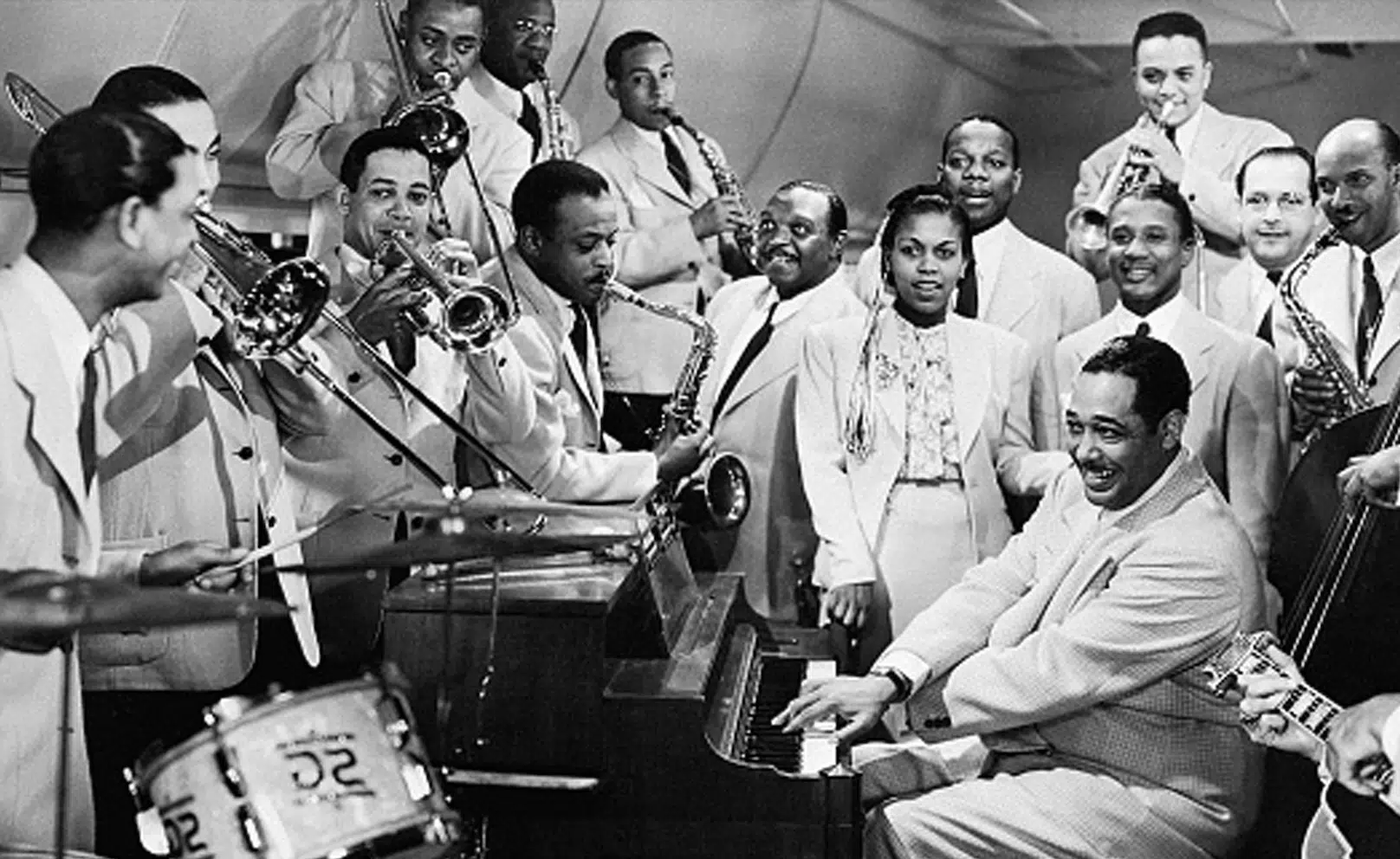
The swing era, spanning the 1930s and 1940s, was a golden age for jazz music and dance music, characterized by the rise of big swing bands.
This period saw the blow up of legendary musicians like:
- Duke Ellington
- Count Basie
- Benny Goodman
Their bands gained national attention and defined the sound of swing music.
Kansas City became a major hub for swing, with its vibrant jazz scene influencing the development (and popularity) of the genre.
And let’s not forget about New Orleans jazz/swing as well.
Big bands during this time, such as those led by Glenn Miller and Fletcher Henderson, played complex arrangements that showcased both the ensemble and soloists.
These Kansas City bands’ rhythmic feel and syncopated rhythm made swing music incredibly popular for dancing, birthing iconic dance styles like the Lindy Hop.
The swing era also saw the rise of smaller swing bands, which played in more intimate venues and contributed to the genre’s evolution.
This period significantly impacted other genres 一 laying the groundwork for later developments in jazz, blues, and pop music.
Understanding the swing era is essential for anyone interested in the history and development of swing music.
Bonus: Swing in Music Production
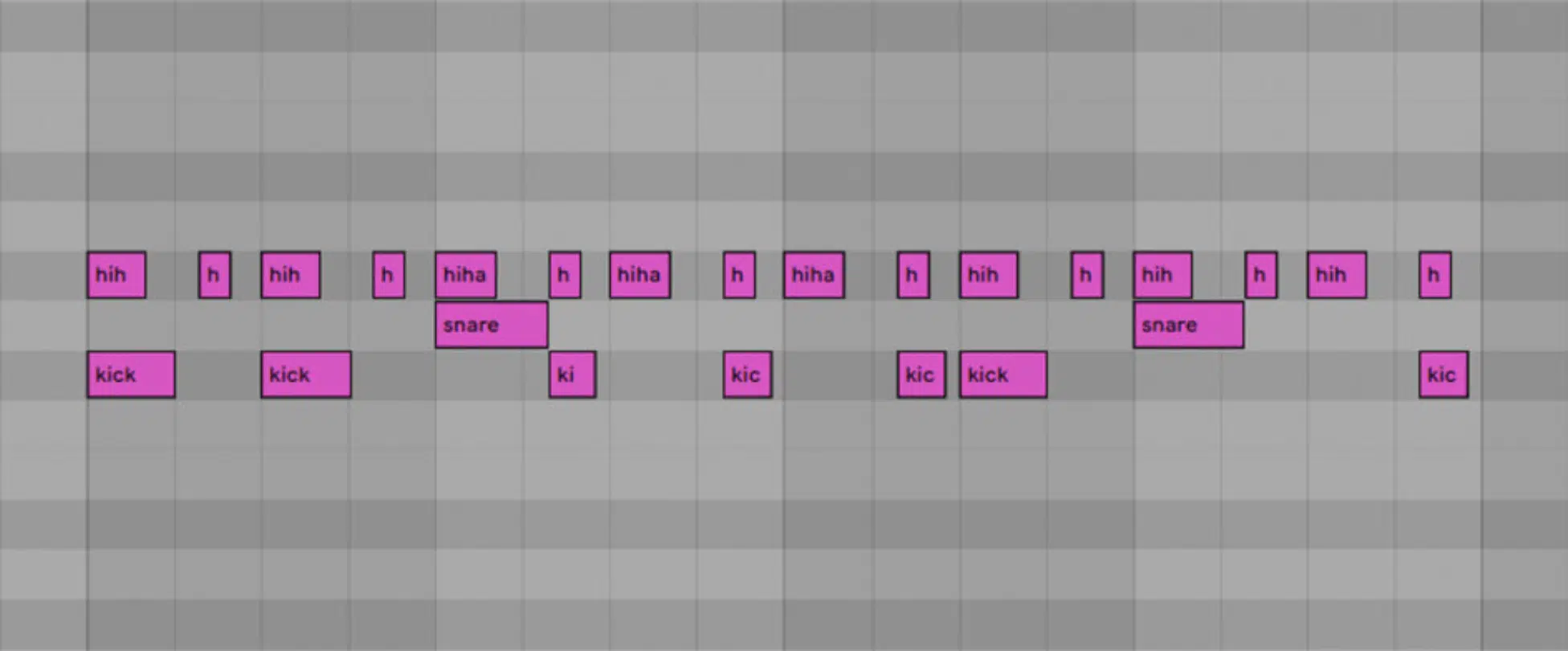
In modern music production/popular music, incorporating swing elements can add a unique and engaging groove to your song.
Many digital audio workstations (DAWs) offer swing quantization, which will help you apply a swing feel to MIDI notes and drum patterns.
It can help create the distinctive long-short pattern of swung eighth notes (or sixteenth note).
As well as give your music a more relaxed and danceable feel, which is what you’re aiming for here.
You can also use shuffle rhythms and syncopation to enhance the groove and add complexity to your tracks.
When working with swing rhythms, it’s essential to pay attention to the interplay between different instruments (particularly the rhythm section).
This includes making sure the bass, drums, and piano work together to create a cohesive and dynamic swing feel.
Listening to classic swing records and studying the rhythmic patterns can provide valuable insights and inspiration for your beats.
NOTE: By understanding and applying these swing elements, you can create music that captures the essence of what is swing in music and appeals to a wide audience.
What is Swing in Music? Final Thoughts
Understanding what is swing in music requires a deep dive into its unique rhythms and feel.
Plus, you have to ensure your timing and accents are spot on to capture that authentic swing groove.
As well as mastering the role of each instrument in the rhythm section, you now have a solid foundation to produce swing music.
Now, after this article, you’ll be able to confidently incorporate swing elements into your tracks and create music with that timeless, infectious groove.
Which is, of course, essential for any serious musician or producer.
To help you master swing rhythms even further, you have to check out the famous Jazz MIDI Drum Collection.
It includes over 250 jazz MIDI drum patterns that are perfect for mastering swing rhythms and enhancing your skills.
Programming jazz drums on your own is super hard given the complexity we talked about.
So, this will be a huge win for you if you produce in this genre or want to get creative with some hybrid genres.
You’ll be able to make your tracks connect with the masses and create addictive tracks like a pro.
With this knowledge about what is swing in music and these golden resources, you can now bring the swing feel into your own music and instantly captivate your audience.
Remember to keep practicing, stay creative, and let the swing groove elevate your productions to new heights.
Until next time…







Leave a Reply
You must belogged in to post a comment.